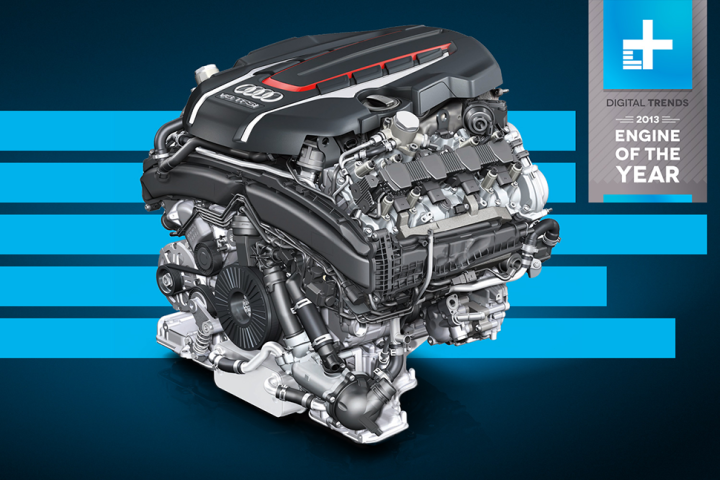
In my line of work, people ask me all the time if I have a favorite car. During any given year, I don’t. Choosing one car is often too difficult. They’re imperfect things. An automaker can get 98 percent of it right, fumble one single feature, and lose my attention.
Ask me what my favorite engine is, though, and I’ll have a quick answer. That’s because I’m a weirdo who finds engine technology hugely engrossing.
I am fascinated with the math and wizardry that allows engineers to shape a lump of aluminum or iron into a seemingly living, breathing thing that can churn out wild amounts of power from nothing but air and a spritz of gasoline.
In years past, I’ve chosen engines for prodigious power or for world-class efficiency. And this year’s engine is a very special thing indeed because it achieves both.
Without further ado, I proudly present the Digital Trends Engine of the Year: the Audi 4.0 TFSI V8.
The figures
Some of you might be scratching your heads, as this engine isn’t exactly new. It originally made its way into the Audi lineup in 2012, in cars like the S6 and S7. In those applications, though, it made 420 horsepower 406 pound-feet of torque.
Admittedly, those are impressive numbers. But the numbers that really caught my attention were those of the 4.0 TFSI’s power output under the hood of the 2014 RS 7, in which it churns out 560 horsepower and 516 pound-feet of torque.
The engine will whip the RS 7 to 60 mph in 3.7 seconds, then on to an electronically limited top speed of 174 mph. Although it is capable of immense acceleration, it still is rated at 16 mpg city, 27 mpg highway, with a combined score of 19. This means that, unlike most 400+ horsepower V8s, the 4.0 TFSI isn’t slapped with a Federal ‘gas-guzzler’ tax.
Details
The 4.0 TFSI V8, as you might have guessed, is a 4.0-liter, twin-turbocharged V8 that was co-developed with Bentley. With a 90-degree angle between the cylinder banks, engineers left more than enough room for the twin-scroll 17.4-psi turbochargers, along with their intercoolers, to rest in the V of the engine.
Audi’s 4.0 TFSI will allow us horsepower junkies to keep efficiently motoring forward – full throttle – for years to come.
The power output of the engine is astounding. What gets me exceptionally excited about it, though, is its cylinder-deactivation technology that reduces its fuel consumption – on average – by five percent.
When the engine is under limited load, running at low-to-moderate RPMs, or the car is in third gear or higher, the engine deactivates cylinders 2, 3, 5, and 8 and fills them with a stroke of fresh air to reduce compression energy. Then actuators push pins into the camshafts, sliding them over to a neutral lifter profile that seals the deactivated cylinders by leaving their intake and exhaust valves closed. Turning the respective fuel injectors and ignition coils off at the same time effectively transforms the V8 into a V4.
Having trouble visualizing the process? This video will help.
As soon as the driver gets back on the accelerator, the cylinders are reactivated in just 300 milliseconds.
Quiet, powerful, and smooth
Ensuring the flop from V8 to V4 and back is a smooth one; Audi cushions the 4.0 TFSI with active engine mounts. The mounts feature an electromagnetic oscillating-coil actuator that essentially vibrates out of phase with the engine, negating engine jitters.
Cleverly, Audi takes that counter-action idea one step further and fits all cars powered by the 4.0 TFSI with a noise-cancellation system. Granted, other automakers do have tried this, too. None, however, works as well as the 4.0 TFSI-paired system.
Called Active Noise Control (ANC), the system uses four microphones mounted into the roof lining to listen for unwanted noise. Based upon engine speed information taken at the crankshaft, ANC emits a targeted and modulated cancellation sound. The result is a tomb-quiet cabin.
End result
Some journalists and industry analysts have hypothesized that V8 engines will soon be a thing of the past, as global fuel efficiency standards are increasingly ratcheted up. This might be true in the long term. In the short term, however, technology like that implemented in Audi’s 4.0 TFSI will allow us horsepower junkies to keep efficiently motoring forward – full throttle – for years to come.




